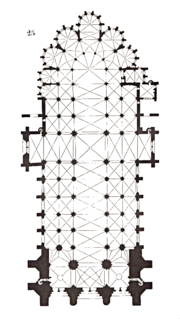
Cathédrale Saint-Pierre-et-Saint-Paul de Troyes
Encyclopedia


France
The French Republic , The French Republic , The French Republic , (commonly known as France , is a unitary semi-presidential republic in Western Europe with several overseas territories and islands located on other continents and in the Indian, Pacific, and Atlantic oceans. Metropolitan France...
, located in the town of Troyes
Troyes
Troyes is a commune and the capital of the Aube department in north-central France. It is located on the Seine river about southeast of Paris. Many half-timbered houses survive in the old town...
in Champagne
Champagne (province)
The Champagne wine region is a historic province within the Champagne administrative province in the northeast of France. The area is best known for the production of the sparkling white wine that bears the region's name...
. It is the seat of the Bishop of Troyes.
Building history and description
The site has been used for religious buildings since at least the 4th century, when an oratoryOratory
Oratory is a type of public speaking.Oratory may also refer to:* Oratory , a power metal band* Oratory , a place of worship* a religious order such as** Oratory of Saint Philip Neri ** Oratory of Jesus...
stood on the site. A cathedral was built in the 9th century, but was badly damaged by Norman
Normans
The Normans were the people who gave their name to Normandy, a region in northern France. They were descended from Norse Viking conquerors of the territory and the native population of Frankish and Gallo-Roman stock...
invasions and was replaced in the 10th century, from about 940, when bishop Milo built a Romanesque
Romanesque architecture
Romanesque architecture is an architectural style of Medieval Europe characterised by semi-circular arches. There is no consensus for the beginning date of the Romanesque architecture, with proposals ranging from the 6th to the 10th century. It developed in the 12th century into the Gothic style,...
cathedral. This building was the location of the Council of Troyes
Council of Troyes
There have been a number of councils held at Troyes:* 867 - proclaimed that no bishop could be disposed without reference to the Holy See* 1129 - convened by Pope Honorius II:...
that opened on 13 January 1128/29, at which the Order of the Knights Templar
Knights Templar
The Poor Fellow-Soldiers of Christ and of the Temple of Solomon , commonly known as the Knights Templar, the Order of the Temple or simply as Templars, were among the most famous of the Western Christian military orders...
was confirmed and its rule established. The Romanesque cathedral was destroyed by fire in 1188.
Construction of the present Gothic
Gothic architecture
Gothic architecture is a style of architecture that flourished during the high and late medieval period. It evolved from Romanesque architecture and was succeeded by Renaissance architecture....
cathedral was ordered in about 1200 by bishop Garnier de Traînel and begun under bishop Hervé in 1208. Work continued until the 17th century. The cathedral only has one tower, St. Peter's; St. Paul's tower to the south was never built, and the building is thus still in fact unfinished. A steeple, with a height of 110 metres, once stood over the crossing
Crossing (architecture)
A crossing, in ecclesiastical architecture, is the junction of the four arms of a cruciform church.In a typically oriented church , the crossing gives access to the nave on the west, the transept arms on the north and south, and the choir on the east.The crossing is sometimes surmounted by a tower...
: it was ruined by a tornado in 1365, and struck by lightning in 1700, after which it was not rebuilt.
The cathedral structure has suffered other natural disasters: part of the choir was destroyed in a hurricane in 1228, and the roof was set alight by lightning in 1389.
The earliest part is the 13th century choir. The elaborate façade dates from the beginning of the 16th century. The three main portals are the work of the architect Martin Chambiges
Martin Chambiges
Martin Chambiges was a French architect from Paris working in the flamboyant gothic style. His chief works are the transepts of Sens Cathedral , of Senlis Cathedral, and of Beauvais Cathedral , in addition to the west front of Troyes Cathedral . He also designed the unusual choir of the church of St...
(c. 1460–1532). The cathedral escaped destruction during the French Revolution
French Revolution
The French Revolution , sometimes distinguished as the 'Great French Revolution' , was a period of radical social and political upheaval in France and Europe. The absolute monarchy that had ruled France for centuries collapsed in three years...
, but was de-Christianised and turned into a Temple of Abundance for several years.
It is particularly noted for its exceptional stained-glass windows of dates from the 13th to the 19th century, with a surface area of 1,500 m², and for the magnificent treasure containing among many other important works the reliquary casket
Reliquary
A reliquary is a container for relics. These may be the physical remains of saints, such as bones, pieces of clothing, or some object associated with saints or other religious figures...
or shrine of Saint Bernard de Clairvaux and his closest friend Saint Malachy
Saint Malachy
Saint Malachy was the Archbishop of Armagh, to whom were attributed several miracles and a vision of the identity of the last 112 Popes...
of Ireland
Ireland
Ireland is an island to the northwest of continental Europe. It is the third-largest island in Europe and the twentieth-largest island on Earth...
.
The cathedral, containing the nave, two principal aisles and two further subsidiary aisles, is 114 metres long and 50 metres wide (across the transepts), with a height from the top of the vault of 29.5 metres; the height of the cupola and the tower is 62.34 metres.

